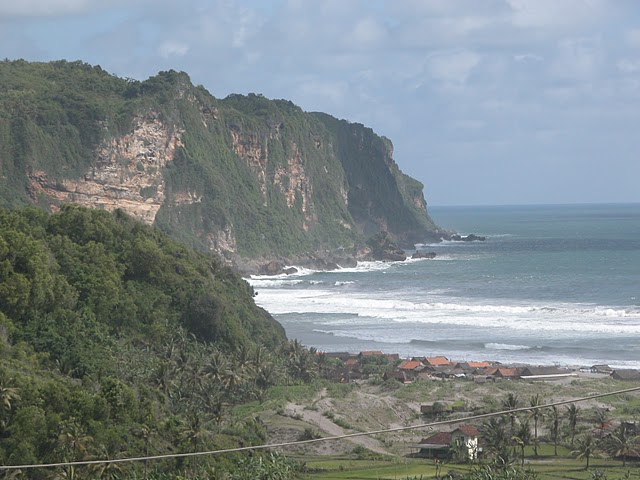Until the 1990s this area was not reached by electricity and is one of the most remote regions in Central Java.Its location is also located on the west complex Sindoro Mountain and Mount Cleft.Dieng is an active volcanic area and it can be said is a giant volcano. Often Crater craters are found there. The average altitude is about 2.000 m. above sea level.Dieng cool temperatures in winter approached, ranging from 15-20 ° C in the daytime and 10 ° C at night. In the dry season (July and August), temperatures can reach 0 ° C in the morning and bring frost by the locals WHO Called the poison bun ("dew poison") Because it Causes Damage to agricultural crops.
Dieng Plateau region is a complex volcano with a cone-cone consists of:Bhishma, Seroja, Binem, Pangonan Merdada, Pagerkandang, Telogo dringo, Pakuwaja, Kendil Sikuunir and Pram.Field fumarola comprises Sikidang Crater, craters Beetle, Sibanteng crater, Crater Upas, Telogo Continues, Crater Pagerkandang, Sipandu Crater, craters and crater Siglagah Sileri.EtymologyDieng name comes from the combination of two words Kawi language: "in" which means "place" or "mountain" and "Hyang" which means (God).Thus, the mean Dieng mountain areas where the gods and goddesses residing. The name comes from the
Sundanese Dieng as predicted in pre-Medang around the year 600 AD, the area was under the influence of the Kingdom Galuh politics."Heaven Dieng 'the which at the time of Chandra Gupta empire Sidhapala, by Hindus, believed to be the axis of the globe. At That time, Sang Hyang Jagadnata move' cosmic mountain 'Mount Meru from India to Dieng. As the capital of the kingdoms, Pls it, Dieng (paradise hyang) not only Became the center of government, but also a center of spirituality and civilization.Previously estimated there are 200 temples around the Dieng. But since natural disasters live 8 That remained. The temples are established by the Kingdom of Kalinga of the Sanjaya Dynasty. In the book of King Sanjaya no mention of the word 'Dieng' is saying is the best place to worship Lord Shiva. So were the resource persons temples built to worship Lord Shiva. Shiva is the god of destruction. Hailed for he does not destroy human life.In the midst of the Dieng plateau before there is a place of worship and residence of Indonesia's oldest Hindu education.That as a sacred building until We can now see with the temples and ruins of the former monasteryGEOLOGYplain the Dieng Plateau is a plateau the which Occurs Because the terrible Eruption of a volcano. Thus the geological conditions are still unstable samapai event geraka Relatively common-ground movement.Some evidence shows That They Will be is, the loss event Legetang Village, the between Banjarnegara Karangkobar terpotongnya road and Sukoharjo Ngadirejo and soil cracks That emit toxic gases as Sinila Such events.Dieng plateau (DTD) is a plateau with volcanic activity below the surface, Such as Yellowstone or the Tengger Highlands. Indeed he is a caldera in the Surrounding mountains as the edges. There are many craters as the discharge gas, water vapor and Various other volcanic material.The situation is very dangerous for the People who inhabit the region, as evidenced by the catastrophic gas explosion crater Sinila 1979.Not only poison gas, but also to possible Earthquakes, mud eruptions, landslides and Floods.Apart from the crater, there are also volcanic lakes contain water That mixed with sulfur and thus have distinctive yellow-green color. In biology,volcanic activity at Dieng interesting Because it is found in hot waters near the crater of some species of thermophilic bacteria ("like heat") That can be used to expose early life on Earth.HYDROLOGYDieng Plateau Area That have springs are upstream of Kali Serayu with Bhishma Lukar source of the which is upstream of times with the water source dati Write the foot of Mount Boat.Water resources in the area of Dieng Plateau widely used by people around the area weeks to agricultural irrigation.NATUREPopulation in the Dieng Plateau Area is 1,562,004 people occupying an area of 1027.21 ± KM.Most of the population consists of Dieng Plateau Regions of Interest extensive Mountains, the which in general are Embracing Islam agarna Abiding and obedient.Nevertheless, They are not closed to the influence of modernization of daily life,They are still only Reluctant to let go of traditional Airways of life as in customary marriage and circumcision ceremony.Medium astronomical location is at about 7:20 º south latitude and 109.92 º East longitude and at an altitude of ± 2.095m altitude dpa.Maybe That Could be included in Google Earth Latitude: -7.20 and Longitude: +109.92.Most of the Dieng Plateau Regions pendudluk Their living from agricultural products.However, Because of the rapid progress in the economy right now, then some of Their livelihood has been shifting to other fields Such as fieldtrade or employment as an employee in the Office of Pernerintahan office. With Increasing levels of domestic and foreign tourists Tourist Arrivals in the Dieng Plateau Area,then in the general population in the vicinity of this tour to benefit / additional income from farming or working at companies That serves the interests of tourists, Such as working in hotels, restaurants and others.








 22.01
22.01
 ucok
ucok






 Posted in:
Posted in: 
































